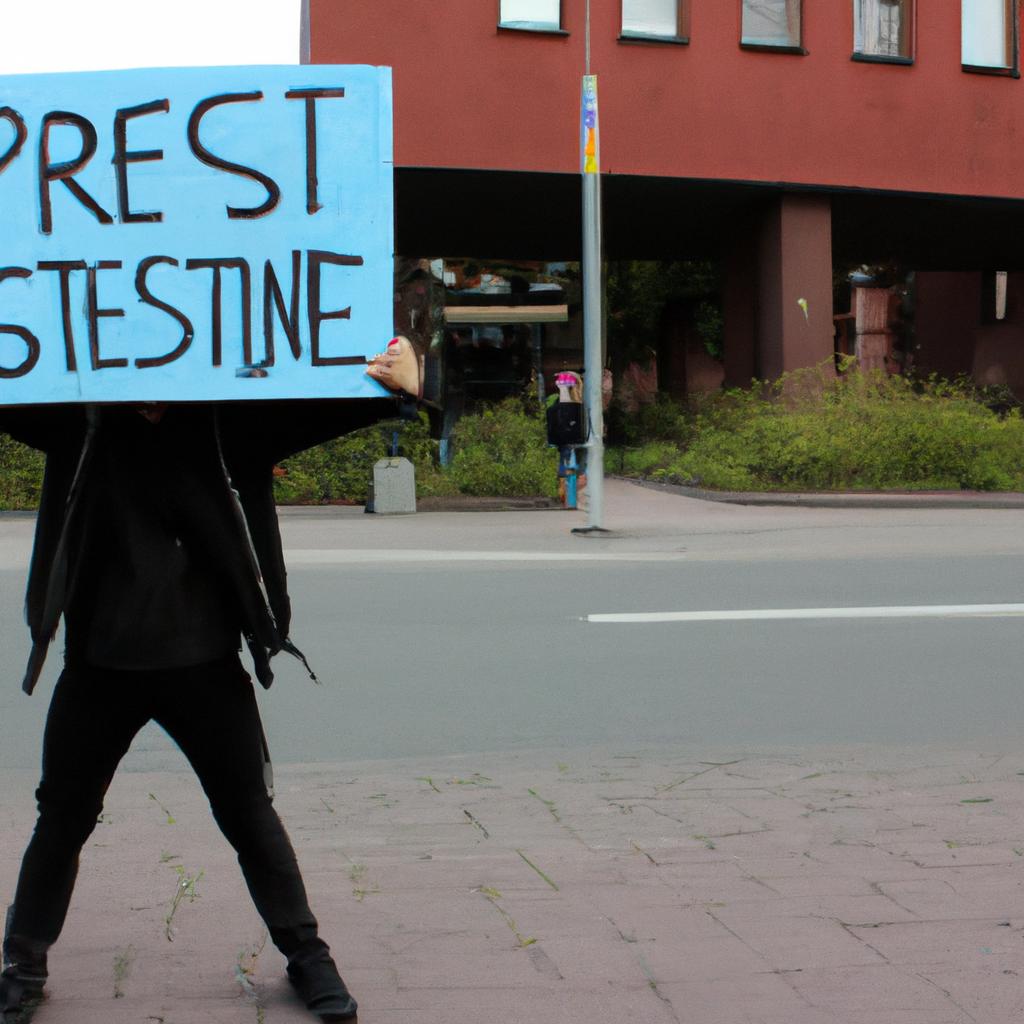Deforestation, the systematic removal of trees from forests or wooded areas, is an issue that has garnered significant attention due to its profound environmental impact. This article aims to shed light on the ravages caused by deforestation and highlight its detrimental effects on ecosystems worldwide. To illustrate the severity of this problem, imagine a hypothetical scenario where a vast expanse of pristine forest in the Amazon rainforest is mercilessly cleared for agriculture purposes. The destruction of such valuable habitat not only disrupts delicate ecological balances but also contributes to climate change through reduced carbon sequestration capabilities.
The consequences of deforestation extend far beyond mere aesthetic changes in landscapes; they encompass dire implications for biodiversity loss, soil erosion, water cycle disruption, and climate change escalation. As native flora and fauna lose their natural habitats, countless species face extinction threats and irreversible ecological imbalances occur. Additionally, with fewer trees available to absorb rainfall and protect against soil erosion, vulnerable regions are at increased risk of landslides and flooding events. Moreover, the reduction in forest cover diminishes evapotranspiration rates which leads to alterations in local weather patterns and exacerbates global warming as less carbon dioxide (CO2) is absorbed through photosynthesis.
In conclusion, deforestation poses significant challenges to our environment and requires urgent attention and action. It is crucial for governments, organizations, and individuals to prioritize sustainable land management practices and implement strategies to mitigate deforestation. This includes promoting reforestation efforts, adopting responsible logging techniques, supporting conservation initiatives, and encouraging the use of alternative sources of income for communities that rely on forest resources. By addressing deforestation comprehensively, we can protect our planet’s ecosystems, preserve biodiversity, and contribute to a more sustainable future for generations to come.
Causes of Deforestation
Deforestation, the widespread clearing of forests for various purposes, has become a pressing environmental issue in recent decades. The causes behind this destructive phenomenon are multifaceted and complex. By examining the interplay between economic factors, agricultural expansion, infrastructure development, and illegal logging, one can gain a better understanding of the drivers behind deforestation.
To illustrate the gravity of these causes, let us consider a hypothetical scenario in Southeast Asia. In this region, rapid economic growth has led to an increased demand for timber products and land for agriculture. As a result, vast areas of pristine rainforests have been converted into palm oil plantations and rubber estates. This case study exemplifies how economic incentives can drive deforestation by prioritizing short-term gains over long-term sustainability.
One compelling way to comprehend the emotional toll inflicted by deforestation is through a bullet point list that highlights its devastating consequences:
- Loss of biodiversity: Deforestation leads to habitat destruction and threatens countless species with extinction.
- Climate change: Forests act as carbon sinks, storing significant amounts of carbon dioxide; their destruction exacerbates global warming.
- Soil erosion: Without tree cover, soils become more vulnerable to erosion by wind and water, hindering agricultural productivity.
- Disruption of livelihoods: Indigenous communities who depend on forest resources for their subsistence face displacement and loss of cultural heritage.
Furthermore, visualizing the impact using a table enhances our comprehension:
| Consequences | Environmental | Social | Economic |
|---|---|---|---|
| Loss of biodiversity | Displacement | Reduced crop yield | Decline in tourism |
| Climate change | Cultural loss | Food insecurity | Decreased revenue |
| Soil erosion | Health issues | Increased poverty | Rising commodity prices |
| Disruption | – | – | – |
In conclusion, it is evident that deforestation is driven by a combination of economic, agricultural, infrastructural, and illegal factors. The hypothetical case study in Southeast Asia showcases the intricate relationship between economic growth and environmental degradation. Moreover, the bullet point list and table demonstrate the wide-ranging consequences of deforestation on both natural ecosystems and human societies.
This analysis now sets the stage for exploring how deforestation impacts wildlife without any explicit transition but subtly alluding to it.
Impact on Wildlife
As we delve deeper into the issue of deforestation, it is crucial to understand the various factors that contribute to this environmental crisis. By examining these causes, we can gain insight into the complex interplay between human activities and their impact on our forests. One example that exemplifies the destructive consequences of deforestation is the case study of the Amazon rainforest.
Deforestation occurs due to a combination of economic, agricultural, and infrastructural factors. These include:
- Expansion of agriculture: The need for increased food production has led to significant forest clearing for commercial farming purposes. Large-scale plantations and agribusinesses often replace diverse ecosystems with monoculture crops like soybeans or palm oil.
- Timber extraction: Logging operations, both legal and illegal, pose a substantial threat to forested areas worldwide. The demand for timber products drives unsustainable logging practices that compromise entire ecosystems.
- Infrastructure development: Construction projects such as roads, highways, dams, and urban expansion require vast amounts of land clearance. This results in widespread deforestation in regions undergoing rapid industrialization.
- Mining activities: Extractive industries indiscriminately clear forests in search of valuable minerals like gold, diamonds, or coal. The excavation process not only destroys habitats but also contaminates surrounding water bodies.
- Loss of biodiversity: Every minute, countless species face extinction as their natural habitats are destroyed.
- Climate change exacerbation: Forests act as carbon sinks; their destruction contributes significantly to greenhouse gas emissions.
- Disruption of ecological balance: Deforestation disrupts intricate relationships among plants, animals, and microorganisms within an ecosystem.
- Threats to indigenous communities: Indigenous peoples who depend on forests for sustenance and cultural practices lose their way of life.
Additionally, let us explore some statistics through a table:
| Annual Deforestation Rate (hectares) | Loss of Biodiversity | |
|---|---|---|
| Amazon | 7,200,000 | High |
| Congo Basin | 1,500,000 | Moderate |
| Southeast Asia | 900,000 | High |
| Central America | 600,000 | Moderate |
The consequences of deforestation extend far beyond the immediate environmental impact. In the subsequent section about “Consequences for Indigenous Communities,” we will delve into how these communities are disproportionately affected by the loss of their ancestral lands and traditional ways of life. As we navigate through this intricate web of cause and effect, it becomes increasingly evident that urgent action is necessary to address and mitigate the devastating effects of deforestation on our planet.
Consequences for Indigenous Communities
Section H2: Consequences for Indigenous Communities
The detrimental consequences of deforestation extend beyond the realm of wildlife, affecting indigenous communities and their way of life. To grasp the gravity of this issue, let us consider a hypothetical scenario where a vast tract of pristine rainforest is cleared to make way for agricultural expansion.
This abrupt transformation disrupts the delicate balance that indigenous communities have maintained with their environment for centuries. Here are some key repercussions:
- Loss of cultural heritage: The destruction of forests robs indigenous communities of their sacred sites, traditional knowledge, and spiritual connection to the land. These ancestral ties are deeply intertwined with their culture and identity.
- Displacement and marginalization: Deforestation often leads to forced displacement as large-scale industries encroach upon tribal lands. This uprooting strips these communities from their homes and exposes them to marginalization and exploitation in unfamiliar surroundings.
- Threats to livelihoods: Forests provide essential resources such as food, medicine, and raw materials used by indigenous communities for sustenance and trade. With dwindling forest cover, these already vulnerable populations face severe challenges in maintaining their traditional subsistence practices.
- Socioeconomic inequalities: Indigenous peoples frequently face economic disparities due to limited access to education, healthcare, and employment opportunities compared to mainstream societies. The loss of forest ecosystems further exacerbates these inequalities by diminishing alternative income-generating activities available to them.
Emotions run high when confronted with the human toll exacted by deforestation on indigenous communities:
- Despair: Witnessing the erosion of ancient cultures and customs can evoke a profound sense of loss among both affected communities and empathetic observers.
- Injustice: Recognizing the systemic inequities that perpetuate the dispossession of indigenous peoples’ rights ignites feelings of outrage against those who exploit their vulnerabilities.
- Empathy: Understanding the struggles faced by marginalized groups cultivates empathy within individuals committed to social and environmental justice.
- Hope: By shedding light on the plight of indigenous communities, we can inspire collective action aimed at empowering these groups and preserving their ways of life for future generations.
| Consequences | Indigenous Communities |
|---|---|
| Loss of cultural heritage | Sacred sites destroyed |
| Displacement and marginalization | Forced relocation |
| Threats to livelihoods | Diminished resources |
| Socioeconomic inequalities | Limited opportunities |
As we delve into the intertwined nature of deforestation and its impact on climate change, it becomes evident that addressing this multifaceted issue requires a comprehensive understanding of its consequences. Deforestation not only disrupts ecosystems but also jeopardizes the survival and well-being of indigenous communities worldwide. Let us now explore the intricate relationship between deforestation and climate change in order to shed further light on this pressing global challenge.
Deforestation and Climate Change
Section H2: Deforestation and Climate Change
The consequences of deforestation extend far beyond the immediate impact on indigenous communities. One example that sheds light on the broader implications is the Amazon rainforest, often referred to as the “lungs of the Earth.” Its massive size and rich biodiversity make it a crucial ecosystem for maintaining global climate stability. However, rampant deforestation in this region has led to alarming environmental changes with severe repercussions.
Deforestation contributes significantly to climate change through various mechanisms. Firstly, trees play a critical role in absorbing carbon dioxide (CO2) from the atmosphere during photosynthesis, acting as natural carbon sinks. When forests are cleared, these CO2-absorbing organisms are lost, leading to increased concentration of greenhouse gases in the atmosphere. This heightened level of CO2 traps heat within the Earth’s atmosphere, causing global temperatures to rise—a phenomenon known as the greenhouse effect.
Furthermore, deforestation disrupts local weather patterns by altering regional climates. Trees release moisture into the air through transpiration, which helps create rainfall and maintain humidity levels. As deforestation reduces vegetation cover, less water vapor is released into the atmosphere, resulting in decreased precipitation and drier conditions. Consequently, affected areas may experience prolonged droughts or an increase in extreme weather events such as hurricanes and floods.
The impacts outlined above highlight just a few of the numerous ways deforestation exacerbates climate change and its subsequent consequences. To emphasize further how destructive this process can be both environmentally and socially, let us delve deeper into some emotional aspects:
- Loss of habitat for countless species
- Displacement of indigenous communities
- Irreversible destruction of unique ecosystems
- Acceleration of global warming due to reduced carbon absorption
In addition to these emotional aspects, consider the following table showcasing statistics related to deforestation:
| Acres Lost Per Year | Carbon Emissions | Species Extinction | |
|---|---|---|---|
| Brazil | 2.7 million | 1.4 billion tons | Over 1600 species |
| Indonesia | 1.6 million | 600 million tons | Over 500 species |
| Democratic Republic of Congo | 0.9 million | 300 million tons | Over 400 species |
| Bolivia | 0.3 million | 100 million tons | Over 200 species |
The staggering numbers presented in this table serve as a stark reminder of the gravity and urgency of addressing deforestation as a global issue.
Transitioning to the subsequent section on “Economic Implications,” it becomes evident that tackling deforestation is not only an environmental imperative but also carries significant economic ramifications for both local communities and the world at large.
Economic Implications
As we delve deeper into the issue of deforestation, it becomes increasingly evident that its consequences extend far beyond ecological concerns. The impact on climate change is a major aspect to consider when discussing the ravages caused by deforestation.
To illustrate this connection, let us explore an example: the Amazon rainforest. Spanning across several South American countries, the Amazon rainforest is often referred to as the “lungs of the Earth” due to its significant role in regulating global oxygen levels. However, rampant deforestation in this region has led to devastating consequences for both local ecosystems and our planet’s climate.
The effects of deforestation on climate change are multifaceted and interconnected:
- Loss of carbon sink: Forests act as carbon sinks, absorbing large amounts of carbon dioxide from the atmosphere through photosynthesis. When trees are cut down or burned during deforestation activities, this stored carbon is released back into the atmosphere as greenhouse gases.
- Disruption of water cycle: Trees play a crucial role in regulating rainfall patterns and maintaining moisture in the air. Deforestation disrupts these processes, leading to decreased precipitation in affected areas and contributing to drought conditions.
- Increased greenhouse gas emissions: In addition to releasing stored carbon dioxide, deforestation also contributes directly to increased greenhouse gas emissions through burning practices associated with land clearing.
- Altered regional climates: Large-scale deforestation can significantly alter regional climates by changing temperature and humidity patterns. These alterations can have cascading effects on agriculture, biodiversity, and human communities reliant on specific climatic conditions.
- Destruction of forests releases significant amounts of CO2 into the atmosphere.
- Reduced forest cover leads to changes in wind patterns and altered rainfall distribution.
- Deforested regions experience higher temperatures due to reduced shading provided by trees.
- Altered microclimates affect plant and animal species, leading to biodiversity loss.
To further understand the implications of deforestation on climate change, consider the following table:
| Consequences of Deforestation | Impact |
|---|---|
| Increased greenhouse gas emissions | Accelerated global warming and climate instability |
| Disruption of water cycle | Decreased precipitation and increased drought conditions |
| Loss of carbon sink | Higher concentration of CO2 in the atmosphere |
| Altered regional climates | Changes in temperature and humidity patterns affecting ecosystems and human communities |
By comprehending these interconnected consequences, it becomes evident that addressing deforestation is crucial for mitigating climate change. In the subsequent section about “Sustainable Solutions,” we will explore effective strategies to combat this environmental challenge head-on.
Sustainable Solutions
Section H2: Sustainable Solutions
Amidst the dire consequences of deforestation, various sustainable solutions have been proposed and implemented to address this environmental crisis. One such solution is the establishment of protected areas, where forests are preserved and monitored to prevent further encroachment. For instance, in the case study of the Amazon rainforest, several national parks and reserves have been designated to safeguard its unique biodiversity and mitigate deforestation.
To effectively combat deforestation, it is essential to consider a multi-faceted approach that encompasses both local communities and global initiatives. Here are some key strategies that can contribute towards sustainable solutions:
-
Community-based forest management: Engaging local communities in decision-making processes regarding forest resources fosters a sense of ownership and responsibility. By empowering these communities with knowledge and resources, they become active participants in conserving their natural surroundings.
-
Reforestation efforts: Planting trees on degraded lands not only helps restore ecosystems but also provides numerous ecological benefits such as carbon sequestration, soil erosion prevention, and habitat restoration for wildlife.
-
Promotion of sustainable land-use practices: Encouraging responsible agricultural practices like agroforestry or organic farming reduces reliance on destructive methods such as slash-and-burn agriculture. These approaches promote long-term sustainability while ensuring food security for local populations.
-
International collaborations: Addressing deforestation requires international cooperation between governments, organizations, and stakeholders worldwide. Collaborative efforts can include sharing best practices, financial assistance programs, technology transfer, and policy coordination.
By adopting these sustainable solutions collectively at various levels – from grassroots initiatives to global partnerships – we can work towards mitigating deforestation’s devastating impacts on our planet’s fragile ecosystems.
| Strategies | Benefits | Challenges |
|---|---|---|
| Community-based forestry | Empowers local communities | Requires capacity building |
| Reforestation | Restores ecosystems | Long-term monitoring and funding |
| Sustainable land-use | Ensures food security | Requires education and awareness |
| International collaboration | Shares best practices | Overcoming political barriers |
Through the implementation of these strategies, a more hopeful future can be envisioned, where forests thrive, biodiversity flourishes, and the ravages of deforestation are gradually reversed. It is imperative that we collectively prioritize sustainable solutions in order to protect our invaluable natural heritage for generations to come.





